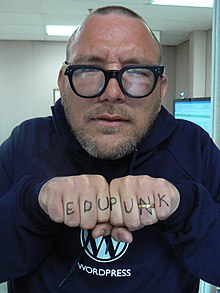Edupunk is a do it yourself (DIY) attitude to teaching and learning practices.[1][2] Tom Kuntz described edupunk as "an approach to teaching that avoids mainstream tools like PowerPoint and Blackboard, and instead aims to bring the rebellious attitude and DIY ethos of ’70s bands like The Clash to the classroom."[3] Many instructional applications can be described as DIY education or edupunk.

The term was first used on May 25, 2008, by Jim Groom in his blog,[4] and covered less than a week later in the Chronicle of Higher Education.[1] Stephen Downes, an online education theorist and an editor for the International Journal of Instructional Technology and Distance Learning, noted that "the concept of edupunk has totally caught wind, spreading through the blogosphere like wildfire".[5]
Aspects edit
Edupunk has risen from an objection to the efforts of government and corporate interests in reframing and bundling emerging technologies into cookie-cutter products with pre-defined application—somewhat similar to traditional punk ideologies.[6]
The reaction to corporate influence on education is only one part of edupunk, though. Stephen Downes has identified three aspects to this approach:
- Reaction against commercialization of learning
- Do-it-yourself attitude
- Thinking and learning for yourself[7]
Examples edit
An example of edupunk was the University of British Columbia's course "Wikipedia:WikiProject Murder Madness and Mayhem" experiment of creating articles on Wikipedia in spring 2008, "(having) one’s students as partners and peers."[8] A video clip illustrating an edupunk approach, produced by Tony Hirst at the Open University in the UK, on 8 June 2008, illustrated how quickly the edupunk concept has been adopted outside North America.[9] A website set up by Australian educators illustrates how edupunk spread,[10] and a presentation by Norm Friesen of Thompson Rivers University identifies a number of possible intellectual precursors for the movement.[citation needed]
Hampshire College, Evergreen State College, Marlboro College, New College of Florida, and Warren Wilson College are collegiate institutions imbued with edupunk ideology.[11][12]
See also edit
Notes edit
- ^ a b Young 2008
- ^ Keats, Jonathon (2008-09-22). "Jargon Watch: Green Crude, Popcorning, Edupunk". Wired Magazine. Retrieved 2008-10-17.
- ^ Kuntz 2008
- ^ Groom, Jim (2008-05-25). "The Glass Bees". Weblog bavatuesdays. Retrieved 2008-05-30.
- ^ Stephen Downes (2008-05-28). "Introducing Edupunk". Retrieved 2008-06-06.
- ^ Cohen, David (2008-06-16). "Nevermind the pedagogues, here's edupunk". The Guardian. London. Retrieved 2008-06-16.
- ^ Rowell, Laurie (2008-07-08). ""Edupunk" Rocks the (Virtual) House". eLearn Magazine.
- ^ Groom, Jim (2008-05-28). "Murder, Madness, Mayhem is so EDUPUNK". Weblog bavatuesdays. Retrieved 2008-06-06.
- ^ Hirst, A. (2008-06-08). "Changing Expectations". YouTube. Retrieved 2008-06-21.
- ^ "edupunk". Archived from the original on 2008-08-27.
- ^ Norm Friesen (2009-02-06). "The Edupunk Heritage: Precursors of Open Learning". Blip.tv. Retrieved 2009-02-23.[permanent dead link]
- ^ Norm Friesen; et al. (2009-02-22). "Open Education: Precursors". WikiEducator. Retrieved 2009-02-23.
References edit
- "Technologist Who Coined 'Edupunk' Defends the Term in a Video Debate". Chronicle of Higher Education. March 3, 2009. Retrieved 2009-03-03..
- Kuntz, Tom (October 17, 2008). "The Buzz for 'Edupunk'". The New York Times. Retrieved 2008-10-17..
- Young, Jeffrey R. (May 30, 2008). "Frustrated With Corporate Course-Management Systems, Some Professors Go 'Edupunk'". Chronicle of Higher Education. Archived from the original on 2008-06-01. Retrieved 2008-06-01..
External links edit
- Anya Kamenetz (September 2009). "How Web-Savvy Edupunks Are Transforming American Higher Education". Fast Company.
- Dolors Reig (June 2008). "¿Movimiento edupunk, socialismo educativo o educación 2.0?". El caparazon.
- Catedra Datos y Digicom (July 2010). "An Edupunk Manifest made in Argentina". [Manifiesto Edupunk]. Archived from the original on 2012-07-23.